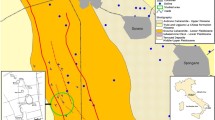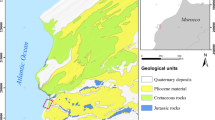Abstract
The Crestatx aquifer is the main source of water supply to the Bay of Alcudia, one of the largest resorts on the island of Majorca (Spain). This water has been used since the 1970s using several pumping wells, which draw an annual volume of 1.5 hm3. The seasonal exploitation of this karstic aquifer causes a substantial cone of depression with great variations in the piezometric level (up to 120 m) and dynamic water levels of down to 87 m below sea level. At the end of the 1990s, several sinkholes and subsidence depressions started being detected in a highly karstified area. Twenty subsidence and sinkhole morphologies have been inventoried in an area measuring 70,000 m2, with diameters up to 23 m and depth more than 15 m. The intense and continuous rainfall during recent years (2008–2010) has considerably accelerated the process, increasing the dimensions of existing sinkholes and the appearance of new morphologies. By means of electrical tomography techniques, a ground study was carried out. Numerous cavities have been identified in the upper 30 m. Using a map of the surface morphologies and the geophysical profiles, we can determine that the propagation and orientation of the sinkholes lie along three main directions: N30°E, N130°E and N60°E. The first is the most relevant, which is parallel to the main tectonic structures in the area. The interpretation of the electrical profiles has enabled us to identify the potentially most unstable areas, which is an effective tool to assess risk in the area, as there are roads and a housing development nearby. The high, but discontinuous, exploitation of the aquifer is considered the main trigger for these sinkholes and subsidence depressions, as it causes large variations of pressure and accelerates the dissolution process in the underlying rock.


















Similar content being viewed by others
References
Abu-Shariah MI (2009) Determination of cave geometry by using a geoelectrical resistivity inverse model. Eng Geol 105(2009):239–244
AEMET (2010) Calendario Meteorológico 2010. Serie Monografías. Edita Agencia Estatal de Meteorología (AEMET). Ministerio de Medio Ambiente y Medio Rural y Marino, 2010
Alvaro M (1987) La tectónica de cabalgamientos de la Sierra Norte de Mallorca (Islas Baleares). Boletín Geológico y Minero 98:34–41
Beck BF (2004) Soil piping and sinkhole failures. In: White WB (ed) Encyclopaedia of caves. Elsevier, Nueva York, pp 523–528
Benedicto A, Ramos E, Casas A, Sabat F, Barón A (1993) Evolución tectosedimentaria de la cubeta neógena de Inca (Mallorca). Revista de la Sociedad geológica de España 6:167–176
Bengstsson TO (1987) The hydrologic effects from intense ground-water pumpage in East-Central Hillsborough County, Florida. In: Proceedings 2nd Multidisciplinary Conference on Sinkholes and the Environmental Impacts of Karst. Balkema, Rotterdam, pp 109–114
Benito G (1987) Karstificación y colapsos kársticos en los yesos del sector central de la Depresión del Ebro. En: Actas de la VII Reunión sobre el Cuaternario, pp 99–102
Benito G, Pérez del Campo P, Gutiérrez-Elorza M, Sancho C (1995) Natural and human-induced sinkholes in gypsum terrain and associated environmental problems in NE Spain. Env Geol 25:156–164
Carbonero MA (1992) L′Espai de l′Aigüa. Petita hidráulica tradicional a Mallorca. Consell Insular de Mallorca, 362 p
Carpenter PJ, Doll WE, Kaufmann RD (1998) Geophysical character of buried sinkholes on the Oak Ridge Reservation, Tennessee. J Environ Eng Geophys 3:133–145
Chen J, Xiang S (1991) Sinkhole collapse resulting from pumping of karst groundwater: a problem and its solution. In: Proceedings 4th International Conference on Land Subsidence, Houston, 12–17 May 1991. Publ IAHS Press, Wallingford, 1991, pp 313–322
Delannoy JJ (1999) Contribución al conocimiento de los macizos kársticos de las Serranías de Grazalema y de Ronda. In: Durán y JJ, López- Martínez J (eds) Karst en Andalucía. Publicaciones del Instituto Tecnológico y Geominero de España, pp 93–129
Edmonds C, Green C, Higginbottom I (1987) Subsidence hazard prediction for limestone terrains, as applied to the English Cretaceous chalk. Geol Soc Eng Geol Sp Publ 4:283–293
Fontboté JM, Guimerá J, Roca E, Sabat F, Santanach P, Fernández-Ortigosa F (1990) The Cenozoic evolution of Valencia Trough (Western Mediterranean). Revista de la Sociedad Geológica de España 3:249–259
Ford D (2000) Speleogenesis under unconfined settings. In: Klimchouk A, Ford D, Palmer A, Dreybrodt W (eds) Speleogenesis evolution of karst aquifers. National Speleological Society, Huntsville, pp 319–324
Galve JP, Bonachea J, Remondo J, Gutiérrez F, Guerrero J, Lucha P, Cendrero A, Gutiérrez M, Sánchez JA (2008a) Development and validation of sinkhole susceptibility models in mantled karst settings. A case study from the Ebro valley evaporite karst (NE Spain). Eng Geol 99:185–197
Galve JP, Gutiérrez F, Lucha P, Guerrero J, Bonachea J, Remondo J, Cendrero A (2008b) Probabilistic sinkhole modelling for hazard assessment. Earth Surf Proc Land 34(3):437–452
Galve JP, Gutiérrez F, Remondo J, Bonachea J, Lucha P, Cendrero A (2009) Evaluating and comparing methods of sinkhole susceptibility zapping in the Ebro Valley evaporite karst (NE Spain). Geomorphoplogy 111(2009):160–172
Gelabert B (1998) La estructura geológica de la mitad occidental de la isla de Mallorca. Colección Memorias del Instituto Geológico y Minero de España, 1998. 129 p
Gelabert B, Sabat F, Rodríguez-Perea A (1992) A structural outline of the Serra de Tramuntana of Mallorca (Balearic Islands). Tectonophysics 203:167–183
Gines J, Ginés A (1995) Les formes exokárstiques de l′Illa de Mallorca. ENDINS-Federación Balear de Espeleología 20:59–71
Gómez-Ortiz D, Martín-Crespo T, Mangato MF (2009) Aplicación conjunta de Georradar y Tomografía eléctrica para la evaluación del riesgo de colapso en la Sima de Madrona (Segovia). Geogaceta 46:35–38
González de Vallejo LI, Ferrer M, Ortuño L, Oteo C (2002) Ingeniería geológica. Pearson Educación, Madrid, p 744
Guerrero J, Gutiérrez F, Lucha P (2004) Paleosubsidence and active subsidence due to evaporite dissolution in the Zaragoza area (Huerva River valley, NE Spain): processes, spatial distribution and protection measures for transport routes. Eng Geol 72:309–329
Guerrero J, Gutiérrez F, Lucha P (2008a) The impact of halite dissolution subsidence on fluvial terrace development. The case study of the Huerva River in the Ebro Basin (NE Spain). Geomorphology 100:164–179
Guerrero J, Gutiérrez F, Bonachea J, Lucha P (2008b) A sinkhole susceptibility zonation based on paleokarst analysis along a stretch of the Madrid–Barcelona high-speed railway built over gypsum- and salt-bearing evaporites (NE Spain). Eng Geol 102:62–73
Gutiérrez F (1998) Subsidencia por colapso en un karst alluvial. Análisis de estabilidad. In: Gómez-Ortiz A, Salvador-Franch F (eds) Investigaciones recientes de la geomorfología española. V Reunión Nacional de Geomorfología, Barcelona, pp 47–58
Gutiérrez F, Galve JP, Guerrero J, Lucha P, Cendrero A, Remondo J, Bonachea J, Gutiérrez M, Sánchez JA (2007) The origin, typology, spatial distribution and detrimental effects of the sinkholes developed in the alluvial evaporite karst of the Ebro River valley downstream of Zaragoza City (NE Spain). Earth Surf Proc Land 32:912–928
Gutiérrez F, Guerrero J, Lucha P (2008) A genetic classification of sinkholes illustrated from evaporite paleokarst exposures in Spain. Environ Geol 53:993–1006
Gutiérrez-Santolalla F, Gutiérrez Elorza M, Marín C, Desir G, Maldonado C (2005) Spatial distribution, morphometry and activity of La Puebla de Alfiden sinkhole field in the Ebro River Valley (NE Spain): applied aspects for hazard zonation. Environ Geol 48:360–369
He K, Liu C, Wang S (2003) Karst collapse related to-over-pumping and a criterion for its stability. Environ Geol 43:720–724
Higgings CG, Coates DR (1990) Groundwater geomorphology; the role of subsurface water in earth-surface processes and landforms. Geol Soc Am Specific Paper, Boulder, CO 252 p
Hyatt JA, Jacobs PM (1996) Distribution and morphology of sinkholes triggered by flooding following Tropical Storm Alberto at Albany, Georgia, USA. Geomorphology 17(1996):305–316
Hyatt JA, Wilkes HP, Jacobs PM (1999) Spatial relationship between new and old sinkholes in covered karst, Albany, Georgia, USA. In: Beck BF, Herring JG (eds) Hydrogeology and engineering geology of Sinkholes and Karst. Balkema, Rotterdam, pp 37–44
Kaufmann JE (2008) A statistical approach to karst collapse hazard analysis in Missouri. In: Yuhr LB, Calvin Alexander E, Beck BF (eds) Sinkholes and the engineering and environmental impacts of karst, vol 183. ASCE Geotechnical special publication, Huntsville, pp 257–268
Labuda ZT, Baxter CA (2001) Mapping karst conditions using 2D and 3D resistivity imaging methods. In: Powers M (ed) Proceedings of the symposium on the application of geophysics to engineering and environmental problems, environmental and engineering geophysical society, CD-ROM, paper GTV-1
Mateos RM, González C (2009) Los Caminos del Agua en las Islas Baleares. Acuíferos y Manantiales. Ediciones del Instituto geológico y Minero de España y la Conselleria de Medi Ambient del Govern Balear, 2009. 280 p
Mateos RM, Murillo JM, García JM (2006) Las fonts Ufanes de Gabellí (Mallorca): propuestas para su aprovechamiento. In: Durán JJ, Andreo y B, Carrasco (eds) Cambio climático y aguas subterráneas. Publicaciones del Instituto Geológico y Minero de España, Madrid, pp 213–218
Mateos RM, López JM, Gelabert B, Marcuello A, Ledó JJ, Queralt P, Murillo JM, De la Orden JA, Ortiz G (2007) Control geológico de la intrusión marina en los acuíferos que abastecen a la Bahía de Alcudia, Norte de la Isla de Mallorca. In: Bosch P, López-Geta JA, Ramos G (eds) Los acuíferos costeros. Retos y soluciones. Coastal auifers: challenges and solutions. Instituto Geológico y Minero de España, pp 155–162
Metcalfe SJ, Hall LE (1984) Sinkhole collapse induced by groundwater pumpage for freeze protection irrigation near Dover, Florida, January 1977. In: Proceedings 1st multidisciplinary conference on Sinkholes. Balkema, Rotterdam, pp 29–33
Neawsuparp K, Soisa T (2007) Application of resistivity survey to investigate sinkhole and karst features in southern Thailand: a case study of Pakjam area. In: Proceedings international conference on Geology of Thailand: towards sustainable development and sufficiency economy, vol I, pp 19–24
Newton JG (1984) Sinkholes resulting from groundwater withdrawals in carbonate terrains, an overview. Eng Geol 6:195–202
Ortiz G (2007) Estudio hidrogeológico del acuífero de Crestatx (Mallorca, Illes Balears). En: 5ª Edición del Curso Internacional de Hidrología Subterránea. Fundación Centro Internacional de Hidrología subterránea (FCIHS). 169 p
Palmer AN (2000) Hydrogeologic control of cave patterns. In: Klimchouk A, Ford D, Palmer A, Dreybrodt W (eds) Speleogenesis evolution of karst aquifers. National Speleological Society, Huntsville, pp 77–90
Panno SV, Wiebel CP, Heigold PC, Reed PC (1994) Formation of regolith collapse sinkholes in southern Illinois: interpretation and identification of associated buried cavities. Environ Geol 23:214–220
Simón JL, Soriano MA (2002) Actual and potential doline subsidence hazard mapping: case study in the Ebro basin (Spain). In: Bobrowsky PT (ed) Geoenvironmental mapping: method, theory and practice. Balkema, Rotterdam, pp 649–666
Tharp TM (1999) Mechanics of upward propagation of cover-collapse sinkholes. Eng Geol 52:23–33
Tharp TM (2002) Poroelastic analysis of cover-collapse sinkhole formation by piezometric surface drawdown. Environ Geol 42:447–456
Tharp TM (2003) Cover-collapse sinkhole formation and soil plasticity. Sinkholes and the engineering and environmental impacts of karst. ASCE, Huntsville, pp 110–123
Tihansky AB (1999) Sinkholes, west-central Florida. In: Galloway D, Jones DR, Ingebritsen SE (eds) Land subsidence in the United States: US geological survey circular, vol 1182, pp 121–140
Waltham T, Bell F, Culshaw M (2005) Sinkholes and subsidence. Springer, Chichester
Williams PW (1983) The role of the subcutaneous zone in karst hydrology. J Hydrogeol 61:45–67
Williams P (2003) Dolines. In: Gunn J (ed) Encyclopaedia of caves and karst science. Fitzroy Dearborn, New York, pp 304–310
Acknowledgments
This study is part of the cooperation agreement between the Geological and Mining Institute of Spain and the Ministry of the Environment of the Government of the Balearic Islands, 2005–2009.
Author information
Authors and Affiliations
Corresponding author
Rights and permissions
About this article
Cite this article
García-Moreno, I., Mateos, R.M. Sinkholes related to discontinuous pumping: susceptibility mapping based on geophysical studies. The case of Crestatx (Majorca, Spain). Environ Earth Sci 64, 523–537 (2011). https://doi.org/10.1007/s12665-010-0876-9
Received:
Accepted:
Published:
Issue Date:
DOI: https://doi.org/10.1007/s12665-010-0876-9




